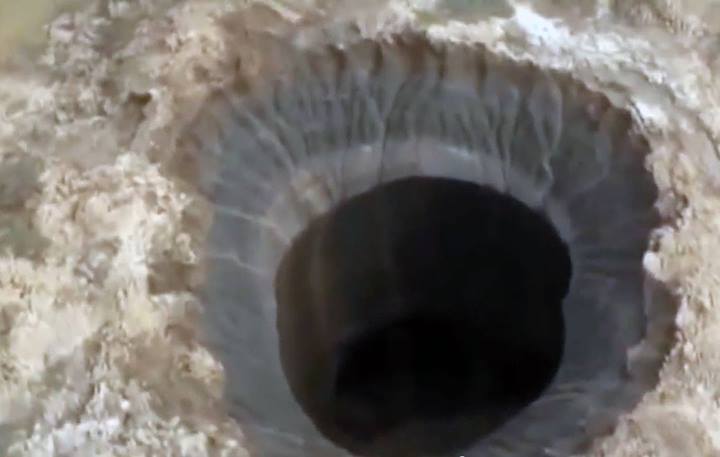Over 30 years of anarchist writing from Ireland listed under hundreds of topics
Siberian craters - Yet another reason that we need action to stop Climate Change

Rather worrying news about those mysterious sink holes that have appeared in Siberia. It now appears they were giant methane releases - long forecast by climate change scientists as a likely positive feedback occurrence as permafrost in Siberia melted and released trapped methane. Worrying because methane is a 20 times more potent climate change gas than CO2 because it is more efficient at trapping radiation.
In mid-July, reindeer herders on the Yamal Peninsula, found the first crater that was 80 meters and since then, two new craters 15 and 70 wide have been found. The cause was a mystery because while sink holes are generally caused by collapse into a cavity below the first helicopter footage showed the crater surrounded by a mound of loose dirt that appeared to have been thrown out of the hole. (Helicopter footage at http://youtu.be/NMlSJlWcJ7k )
A team of Russian scientists have now researched the area and reported in the prestigious science journal Nature that methane was found in the crater at a concentration of 9.6%, a massive increase over the average of 0.000179% found in the atmosphere. Nature adds that “Over the past 20 years, permafrost at a depth of 20 metres has warmed by about 2°C, driven by rising air temperatures, notes Hans-Wolfgang Hubberten, a geochemist at the Alfred Wegener Institute in Potsdam, Germany.
Hubberten speculates that a thick layer of ice on top of the soil at the Yamal crater site trapped methane released by thawing permafrost. “Gas pressure increased until it was high enough to push away the overlying layers in a powerful injection, forming the crater,” he says. Hubberten says that he has never before seen a crater similar to the Yamal crater in the Arctic.” (Read more at http://www.nature.com/news/mysterious-siberian-crater-attributed-to-meth... )
Methane Hydrate may have “abundance range between 100 and 530,000 gigatons of carbon. Values between 1000 and 5000 gigatons are most likely. That is around 100 to 500 times as much carbon as is released into the atmosphere annually by the burning of coal, oil and gas.” Scientists think most of these deposits are in areas not likely to be effected by global warming in the short term. But the existence of deposits like those that appear too be the case of the Siberian craters was previously “controversial, as such shallow gas hydrates would clearly be highly susceptible to dissociation in response to climate warming.” (Read more at http://www.nature.com/scitable/knowledge/library/methane-hydrates-and-co... )
The concern is the possible creation of a major posse feedback loop where climate change resulting in increased temperatures in the tundra leads to permafrost thawing and the release of methane. The methane causes additional warming leading to additional release of methane etc. At the moment looking at available evidence many scientists think such a loop is unlikely but as with other aspects of climate change it’s not fully predictable and represents yet another potentially disastrous tipping point.
The root problem is the global capitalist economy that goes into crisis if growth ever slows to 2% or less. But growth translates to greater extraction of natural resources and escalating climate change. The Kyoto and other attempts at international deals have been a failure due to the ‘dog eat dog’ nature of capitalist competition. We need a very different economy that serves society rather than the profit of a few.
WORDS Andrew Flood (Follow Andrew on Twitter )
Update: Aug 14th 2014
This blog argues in what seems to me to be a well argued fashion that this event is probably nothing to worry about (beyond as an example of climate change causing local warming)
"Short answer: It would take about 20,000,000 such eruptions within a few years to generate the standard Arctic Methane Apocalypse that people have been talking about."

